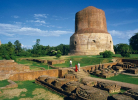Dashashwamedh Ghat, Varanasi
Dashashwamedh is one of the most important tourist destination and spiritually important site in Varanasi. The Ghat is located closer to Shri Kashi Vishwanath Temple, and is famous for the Ganga Aarti ceremony.
Location of Dashashwamedh Ghat
The Dashashwamedh Ghat is located in Godowlia region of Varanasi.
- Distance between Dashashwamedh Ghat and Shri Kashi Vishwanath Temple – 650 m (4 minutes)
- Distance between Dashashwamedh Ghat and Varanasi Jantar Mantar – 220 m (2 minutes)
- Distance between Dashashwamedh Ghat and Manikarnika Ghat – 950 m (5 minutes)
- Distance between Dashashwamedh Ghat and BHU campus – 4.1 km (12 minutes)
- Distance between Dashashwamedh Ghat and Varanasi Cantt railway station – 6.8 km (23 minutes)
- Distance between Dashashwamedh Ghat and Lal Bahadur Shastri International Airport – 24.8 km (41 minutes)
History of Dashashwamedh Ghat
The current structure of the ghat was built in 1774 by Ahilyabai Holkar, the crown queen of Indore. However, the legends take back to the mythology. According to legends, Lord Brahma scarified ten horses and performed a ritual at the ghat to welcome Lord Shiva to Varanasi. However, some scriptures mention that a local king performed the ten horse sacrifice in 2nd century. There are no clear indications to how the ghat was built.
Significance of Dashashwamedh Ghat
The main importance of the ghat is the Ganga Aarti. It is a ritual, which thanks Ganges River for her water and nourishment. Every evening, a grand rhythmic ritual takes place with twirling of oil lamps, chorus chanting, offering of flowers, and others. The Aarti starts at sunset and goes on for 45 minutes.
The Dashashwamedh Ghat is seen as the residing spot of Goddess Shitala, who is considered as the element of life and death. The Goddess is believed to remove evil and pain from the soul of the followers. Thus, people offer prayers to their dead ancestors to allow them seek peace in afterlife.
Tourist Attractions in Dashashwamedh Ghat
- Lively ceremony of Ganga Aarti at sunset.
- Boat ride from the ghat to the surrounding regions, especially Manikarnika Ghat
- Watch pandits and locals offering prayers to their dead relatives under a bamboo umbrella
- A holy dip at Dashashwamedh Ghat is said to be purifying.
- Walk through the Vishwanath Gali to enjoy shopping and street food.
- Visit Kashi Vishwanath Temple after taking a holy dip in the ghat. This is said to provide salvation.
- Pouring milk into the river from this ghat is said to please River Ganges.
How to Reach Dashashwamedh Ghat?
Dashashwamedh Ghat is one of the most significant ghats of the River Ganges. You can find auto rickshaws, buses and other road transportations up to the Vishwanath Gali. From the market region, one has to walk a few hundred meters to reach the ghat. If you couldn’t get the direction right, you can always ask any bystander to point you towards the direction of the ghat.
Best Time to Visit Dashashwamedh Ghat
Tuesday is the best time to visit Dashashwamedh Ghat as special Ganga Aarti takes place. Dashashwamedh Ghat is livelier during evenings. If you wish to watch the morning rituals or take boating, early morning is quite beautiful. The ghat is at prime beauty throughout the year. However, Varanasi’s hot and humid climate makes it hard to enjoy the attractions during summer season. The best time to visit the ghat is during winter, which starts in October and ends in March.











